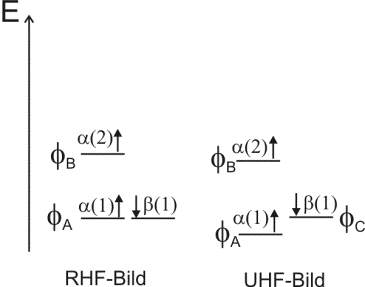
Beispiel: 3-Elektronensystem mit der MO-Besetzung (fA)2(fB)1
Für diese drei Elektronen gibt es folgende Wechselwirkungen:
1. Coulombabstoßung: a(1) – b(1)
a(1) – a(2)
b(1) – a(2)
2. Austauschwechselwirkung: a(1) – a(2)
Zusätzlich (im Gegensatz zum b-Spinelektron in fA) gibt es also eine stabilisierende Austauschwechselwirkung des a(1) in fA mit a(2) in fB. Dadurch wird die MO-Energie für a(1) stabilisiert und liegt in einer UHF-Rechnung, also wenn für a(1) und b(1) unterschiedliche Ortsfunktionen benutzt werden, energetisch tiefer. Die beiden Spins für die a(1)- und b(1)-Elektronen kompensieren sich dann nicht (Spinpolarisation).

ROHF (Restricted Open Hartree-Fock)
Hier wird ein Teil (z.B. core-Elektronen) der MO’s doppelt besetzt, der anders Teil (Valenzelektronen) einfach besetzt behandelt.
Open shell SCF calculations are performed in GAMESS by both
the ROHF code and the GVB
code. Note that when the GVB code is executed with no pairs, the run is NOT a
true GVB run, and
should be referred to in publications and discussion as a ROHF calculation.
The ROHF module in GAMESS can handle any number of open shell electrons,
provided these
have a high spin coupling. Some commonly occurring cases are:
one open shell, doublet:
$CONTRL SCFTYP=ROHF MULT=2 $END
two open shells, triplet:
$CONTRL SCFTYP=ROHF MULT=3 $END
m open shells, high spin:
$CONTRL SCFTYP=ROHF MULT=m+1 $END